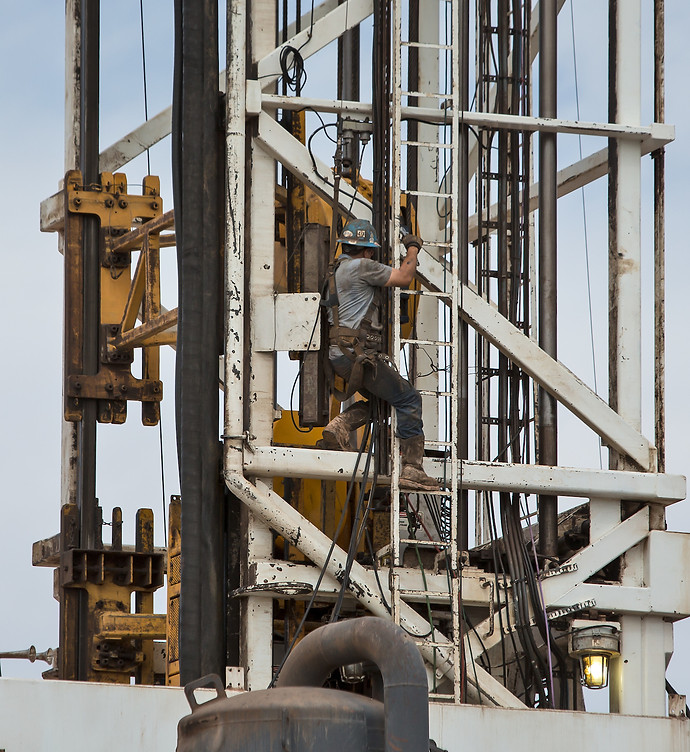
Oilfield worker on a fracking rig in Midland, Texas, in the Permian Basin. 2014
Credit: Julie Dermansky Photography
THE FUTURE OF ENERGY & WORK IN THE UNITED STATES: THE AMERICAN OIL & GAS WORKER SURVEY
At the end of 2021 and beginning of 2022, we circulated a cross sectional survey via social media platforms and through word of mouth. In total, 1,635 workers completed the survey.
Our survey included 38 questions aimed at oil and gas workers throughout the United States. In preparing the survey, we consulted with former American oil and gas workers that compelled us to include additional questions regarding workplace safety practices. We also cast a wider net inviting workers beyond upstream jobs (exploration and production) and included midstream (transportation and construction) and downstream (refinery and chemical) workers. Workers expressed gratitude for the opportunity to say their piece to a larger audience. As one survey respondent said, “I wish people knew our stories.”
Workers from all over the United States shared their experiences, their candid opinions on current industry conditions, future opportunities, and specific recommendations on the future of energy and work. Of the 1,635 survey respondents, 629 workers identified as working in oil and gas exploration and production (upstream); 665 workers identified as working in oil and gas support activities (including transportation, shipping or pipelines); 218 workers identified as working refining and petrochemical; and 123 workers identified as “other.”’
Key Findings
Job Security
-
Over half of the survey respondents have lost their jobs at least once previously to 2020, evidence that the oil and gas industry has already been systematically reducing its workforce.
-
More than half of the survey respondents lost their jobs in 2020.
-
Workers expressed anxiety about not being able to do anything else outside of the oil and gas industry and a preference for work that utilized existing competencies.
Pay & Benefits
-
Average wages in the oil and gas industry have declined. Workers complained about having been fired and then re-hired for the same work at lower pay.
-
Just under a quarter of survey respondents are 1099 independent contractors.
-
Wages in emerging alternative energy industries are not competitive enough to attract oil and gas workers.
Safety and Working Conditions
-
Just under half of survey respondents believe that their company’s safety program was explicitly or implicitly designed to shift liability of an accident onto the worker.
-
A third of survey respondents indicated that they had been ordered to engage in unsafe working practices that were in direct violation of established safety practices.
-
Crew sizes are shrinking with more work expected of each worker. Smaller upstream operators appear to be under staffed intentionally to save money.
-
Newer, younger hires are not being trained adequately.
Future Opportunities
-
Many workers expressed deep distrust of the government, but also acknowledged a potential role for certain agencies. If oil and gas companies do not rehire workers to previous levels, then many respondents said that the government should provide wage replacement (37%), health insurance benefits (35%), and fund training for workers to find new employment (42%).
-
Certain geographic regions expressed a greater interest in renewable energy. For example, Gulf of Mexico regional respondents demonstrated a greater interest in offshore wind.
-
Over half of workers supported a federal jobs guarantee defined in the survey as a guaranteed public job in infrastructure repair and other public good projects with baseline benefits of health insurance, paid sick leave/vacation, and retirement.
-
Just under half of workers supported direct federal employment to plug oil and gas wells.
Compared to oil and gas employment data, the survey tells a story of a workforce already in transition. All segments of the oil and gas industry have learned to do more with less. Each worker’s individual productivity has skyrocketed, as more and more products are being extracted, transported, and processed with fewer and fewer workers. As the directional driller, “Archer” put it, “in the long run these crews drill themselves out of work.” Workers complained that current trends places greater pressure on remaining, smaller crews and compounds the risk each worker must face each shift.
Survey responses reveal that workers know what needs to be done to improve current conditions: increase the size of crews, provide more comprehensive training to newer hires, decrease length of shifts and increase time between shifts, and improve regulatory oversight and enforcement. Workers know what will attract them to other industries: better pay, full time contracts with benefits, job security, and paid training linked to actual jobs on the other side. American oil and gas workers know that their skills are transferable, but businesses and the government have to be better at putting those skills to work.
Workers also acknowledge that an energy transition, at least in part, is underway. Survey respondents expressed support of American energy security whatever form that energy takes. As one Texas upstream worker put it, “the transition away from O&G needs to be planned and managed so as to happen smoothly over the next 20 to 50 years.” Who will be in charge of that transition and where benefits will flow has yet to be determined.


